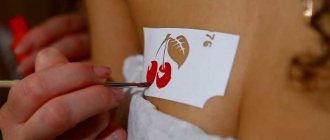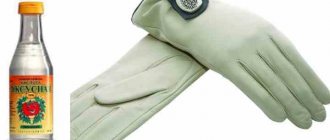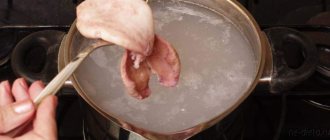What is household stainless steel?
This material is an alloy of iron and carbon. It also contains other special elements that may vary depending on the quality of the steel. Most often, stainless steel uses chromium, which gives the material a shiny appearance.
Products made from this material are among the most durable and have an extended service life due to their resistance to external irritants. Their feature is a mirror surface, which requires additional care.
The chromium content in the metal ensures the appearance of an oxide film that protects the material from corrosion. Humid air and many other factors affect the condition of the alloy over time, causing plaque to appear on it.
If you notice signs of corrosion, you must immediately take action in the form of polishing the metal. If scratches appear on the surface of the product, they also need to be eliminated, since moisture enters the structure of the product through the cracks, which will lead to corrosion.
Abrasive method
In this case, the polished stainless steel is subjected to processing of the outer or inner surface with abrasive substances. Different grain fractions are used. Using the abrasive method, an absolutely smooth surface is obtained, often even mirror-like. Although processing with coarse abrasive can be used at the manufacturing stage. This is how the cheapest stainless steel profile pipes are made. In other cases, polishing a stainless pipe begins with grinding with a coarse-grained abrasive, then the grain diameter is reduced and the process moves on to the finest processing. It involves felt rollers.
This polishing method is called cylindrical grinding and is most often used for pipes - processing internal and external surfaces. Stainless steel products are subjected to belt grinding, which uses elastic belts, and abrasive suspensions based on metal oxides are used as an additional means. Typically, the abrasive grain diameter in this case does not exceed 5 microns. It is also worth adding that abrasive polishing can be dry or wet. In the second case, the particles are carried by water.
Polishes
Grinding of stainless steel is carried out using hand tools with an electric drive. The following are used as additional accessories:
- a circle of felt or felt, a napkin, and also a disk;
- roller;
- abrasive sheet, disc with an abrasive base;
- non-woven materials;
- polishing tapes.
The tools are:
- orbital sanders;
- grinders with a set of attachments;
- belt type machines;
- tape cutter for direct processing;
- portable sanders;
- tape-type files with the ability to rotate the attachments.
Stainless steel polishing products
How to polish stainless steel?
There are two options that will make it possible to polish stainless steel products.
Option #1. Specialized assistance
Now there are a lot of companies that provide assistance when problems arise with stainless steel corrosion. If you do not have enough time to get rid of stains on the product yourself, you can contact a specialist.
Option #2. Polishing at home
At home, you can also carry out all the necessary manipulations for a positive effect and restore the appearance of the product. There are also several ways to do this. Next, we will look at how you can polish stainless steel at home.
Polishing process
To polish stainless steel at home, you will have to spend quite a lot of time and effort. If successful, they will be fully justified, and you will be able to restore the former shine to the products.
Primary processing
Before starting work, be sure to thoroughly clean the product, as it may contain grease and other substances that clog the cracks in the metal. To do this, you can use a simple dishwashing gel:
- The detergent must first be diluted with water to obtain a soap solution.
- Wipe the surface of the metal product without leaving it until completely dry.
- Apply the solution to continue wiping.
- Rinse the soapy area with running water.
- The product must be dried naturally so that streaks do not appear on it.
Some foods, liquids with chemicals, and even household tools will help you polish products at home. With their help, you can polish stainless steel to a mirror.
Olive oil
This method is suitable for use on products that have lost their brightness. You will need olive oil and a soft cloth.
- The oil should be applied to a clean cloth.
- After this, spread the oil over the surface in a circular motion, distributing it evenly.
- The oiled cloth must be pressed tightly and the previous procedure must be repeated several times.
You need to polish using this method until you feel a change in the structure of the product.
Be careful as oil may dull the surface. Its excess must be removed immediately upon completion of the above operation. Using a dry cloth in a circular motion, you can easily remove any remaining oil.
Flour
You can polish stainless steel using flour only on the condition that the work will be done on flat surfaces. In particular, you can try it on pots and sinks.
Mode of application:
- The product must be sprinkled with flour, covering the entire surface.
- Spread the flour evenly over the metal.
- Polish the stainless steel in a circular motion using a dry cloth.
- Once the process is complete, remove all flour from the surface using a toothbrush.
Plasma polishing
The technology differs from the electrochemical procedure in the following parameters:
- the solution is not aggressive, disposal does not require special cleaning;
- voltage is higher (220 V);
- temperature is about 100 °C.
The reagent used is ammonium salt with a concentration in the solution of 3.1 ÷ 6.0%. The electric current density is set at 0.35 ± 0.15 A/cm²; gas bubbles are intensively formed in the contact zone of the electrolyte with the stainless steel. Discharges occur in the vapor inside the fluidized bed, ionizing the medium. Plasma tongues appear that specifically act on the steel, polishing it. The time required for one dive is within 6 minutes, based on a power consumption of 5 Wh/cm².
For a stable process of polishing a surface of a certain area using the electroplasma method, the appropriate power of the installation is required. You cannot reduce its value in the hope of increasing the duration of treatment in the bath. The conditions for the formation of a plasma-ionized layer will not be met.
Unscrupulous mechanical preparation will be evident. Residual traces of welds, scratches, and dents cannot be hidden with polish.
Where can I polish?
In order for the surface of the alloy to be beautiful and smooth, you need to polish the stainless steel. Nowadays, there are many companies whose specialization is this particular procedure; they put in order various products made from this alloy. But it turns out that you can polish stainless steel at home.
Of course, if you need better quality work, it is better to seek help from specialists. For example, a polished square stainless steel pipe will look much more impressive after factory processing than after home processing.
Any company that specializes in polishing will easily perform this procedure.
Grinding and satining (matting) the seam on a profile pipe
Consumables
The process of processing such as satin-finishing is not much different from processing under a mirror.
The sequence of using consumables begins in the same way as in the previous example. Only instead of felt we use a satin finish.
Sanding roller . After the Velcro sanding wheel with P-320 grit, a sanding roller is used. It is attached to a low-speed angle grinder using an adapter.
After the sanding roller, the surface is finished with Scotch Brite. We use
You can also refine the sanded surface with a sanding sponge. And a matte surface can be achieved with the same sponge after polishing the metal.
Small mechanization
You can polish stainless steel to a mirror not only in special companies or at a factory, but also at home. A little mechanization will be enough for this.
This method is suitable for giving products an attractive and presentable appearance after removing flaws.
To polish stainless steel you will need to use the following:
- “grinder”, or angle grinder;
- felt or felt circles;
- stone or sandpaper;
- polishing agent;
- grinding wheels with different grain sizes.
Polishing stages
Polishing of products takes place in several stages. Initially, you need to remove all excess metal from the seams. An angle grinder is perfect for this. For it you will have to purchase a fiber-based circle. Its grain size should not exceed P60.
If the surface of the desired product is smooth, this intermediate step can be ignored. Next, you need to grind the metal with another wheel, the grit of which is P120. This will allow you to get rid of streaks that appear after working with other grains.
The size of the abrasive must be reduced each time, which will make it possible to make the surface smoother.
If you don't have the circle you need, you can easily make one yourself. To do this, you will need a felt or felt circle, onto which you need to apply wood glue. You can also simply rub sandpaper and stone together.
After the work is completed, all traces of sanding must be removed.
Take the polish and apply it to the surface.
Next, you need to grind the material or product using paste. Risks must be removed consistently. If over time the surface does not become smoother, the speed of the grinder can be gradually increased. Do not overuse the speed, as this can lead to overheating of the metal and the appearance of stains on it.
Mechanical polishing by hand
Due to the presence of various irregularities on most products, it is often necessary to polish them manually. You will have to be patient, as polishing stainless steel to a mirror using the method described below can take a lot of time. During the work you will need:
- abrasive paste;
- soft felt.
Polishing stages
- You need to apply paste to the felt.
- Polish the product to a shine, carefully treating the most problematic areas.
In order to protect yourself from the negative effects of the substances that make up the paste, use a face mask and gloves.
Chemical method
Small stainless steel parts are processed using a method that does not require much physical effort and several hours of work. Using circles can just be awkward. Immerse the cleaned workpiece in a bath with strictly dosed reagents, diluted to the required concentration with distilled water. Over a sufficient period of time, under the influence of caustic reagents, all steel roughness in contact with the liquid active medium is eliminated. Deep scratches and welding marks are first leveled with emery wheels, then smoothed with soft circles with paste of the required grain size (GOI). Otherwise, all large flaws will also be polished while maintaining their shape.
To correctly select components and their concentration in the water mass, it is advisable to know the grade of stainless steel:
- Brand X18N9T is immersed in the following composition: acids: 230 ml sulfuric, 40 ml nitric, 70 ml hydrochloric. To 1 liter of solution add acid black dye - 6 g, wood glue - 10 g, sodium chloride - 6 g. The liquid temperature is maintained at 65-70 ° C, time 5÷30 minutes.
Other options:
- Acids in proportion to the total volume: nitric 4÷5%, orthophosphoric 20÷30%, hydrochloric 3÷4%, methyl orange - 1÷1.5%, in an aqueous solution with a temperature of 18÷25 ° C, Approximate holding time 5÷ 10 min .
- Per liter of composition the amount of acids: sulfuric 230 g, hydrochloric 660 g, orange acid dye - 25 g. Maintain a temperature of 70÷75 ° C, time 2÷3 minutes.
To complete the reaction at all points and remove the resulting products, the liquid in the container is continuously stirred. You can move the steel part.
The components are aggressive. Provide protection for the skin of the hands, face, eyes, and respiratory organs.
Chemical alignment of the line of the outer boundary of the stainless steel (polishing) occurs because the reaction is more intense on the protrusions of the profile. To prevent the accumulation of interaction products in depressions, recesses, and corners, fluid movement is forced. After washing off the chemical reagents, rub with a napkin with a small amount of polish.
Chemical polishing method for stainless steel
This method is perfect for working with small parts that are difficult to polish by hand. The method does not require effort or physical labor. There are several methods for preparing chemical liquid for polishing products at home.
Option #1
The solution must be prepared with the most accurate dosage:
- Sulfuric acid – 230 milliliters.
- Hydrochloric acid – 70 milliliters.
- Nitric acid – 40 milliliters.
To 1 liter of solution you need to add 6 grams of black acid-based dye, 6 grams of sodium chloride, 10 grams of wood glue.
It is important to keep the liquid temperature between 65 and 70 degrees.
Stainless steel should remain in the composition for up to 30 minutes, depending on the degree of contamination.
Option No. 2
This solution also needs to be prepared in compliance with the proportions in the total volume:
- Methyl orange – 1.5 percent.
- Nitric acid – 4-5 percent.
- Hydrochloric acid – 3-4 percent.
- Phosphoric acid – 20-30 percent.
The part should be kept in the solution for up to 10 minutes, depending on the degree of contamination, at a temperature of 18 to 25 degrees.
Option #3
The solution is made according to the recipe for one liter of volume of the finished liquid:
- Hydrochloric acid – 660 grams.
- Sulfuric acid – 230 grams.
- Acid orange dye - 25 grams.
The solution must be brought to a temperature of 70-75 degrees and keep stainless steel products in it for about 3 minutes.
All of the above components react aggressively when they come into contact with the human body. Provide full protection for your respiratory system, face, hands and eyes.
Polishing stages
- The part, which has previously been cleaned of contamination, must be immersed in a solution consisting of reagents and clean distilled water.
- The solution must be constantly stirred to ensure a complete chemical reaction.
- After the time specified in each option has expired, the product must be removed and all reagents washed off from it. After this, it is recommended to wipe the item with polish applied to a napkin.
- Under the influence of reagents that remain in the pores on the surface, the roughness on the stainless steel will completely disappear.
Before starting work, you need to find out the grade of the metal, since its composition may depend on it. According to it, it is worth selecting reagents and determining their concentration in the solution.
Methods for polishing stainless steel
There are several technologies for polishing stainless steel, among which the most common are mechanical, chemical and their varieties.
Mechanical is used to restore the mirror finish of stainless steel directly on site, as well as for workshop repairs and processing of small batches of products. When in-line processing of stainless steel parts at industrial enterprises, as a rule, the method of electropolishing in chemical solutions is used.
You can bring stainless steel to a shine at home using methods and means available to everyone.
In case of minor damage or oxidation, the surface of a stainless steel product can be easily brought to a shine using polishing paste or chemical polishing reagents. If scratches and gouges on stainless steel are of a significant size, then mechanical grinding must first be performed.
Mechanical polishing
When mechanically polishing stainless steel, microprotrusions of the metal are cut off using abrasive grains.
In this case, the tools used are circles, discs, rollers and tapes, and the abrasive materials are polishing pastes and suspensions. Some of them contain chemical components that, together with the abrasive, act on micro-irregularities. This type of processing is called chemical-mechanical polishing of stainless steel. After machining or rolling, longitudinal stripes and grooves remain on the surface of stainless steel products. These irregularities, in the best case, have a roughness class of 6–7, so grinding stainless steel to class 8–10 is a prerequisite for preparing for the polishing operation, since classes 11–14 correspond to this type of processing.
Mechanical polishing of stainless steel can be done manually, without the use of power tools or special devices. This treatment is most common in everyday life and for small volumes of repair and restoration work. The following types of production equipment are used in production plants for polishing stainless steel:
- hand-held electric and pneumatic tools;
- polishing machines;
- drum and vibration devices;
- magnetic abrasive installations.
VIEW Polishing machines on AliExpress →
The most common abrasive materials for polishing stainless steel are various liquid polishes, suspensions and pastes that allow you to achieve the best results in terms of roughness. Most of them are based on technical oils, fats and substances such as paraffin and stearin, which have to be removed from the surface of the stainless steel using organic solvents.
Electrochemical method
The technology of electrochemical polishing (ECP) of stainless steel is based on the process of movement of metal ions from the anode to the cathode.
In general, such an installation consists of a metal bath with electrolyte connected to the negative pole of a direct current source (cathode). A stainless steel product is immersed in it, to which a positive potential is applied, i.e. it is the anode. When direct current is passed through the electrolyte, positive metal ions begin to detach from the surface of the stainless steel.
To a greater extent, this occurs from the tops of microprotrusions, which are thus smoothed out (see figure below). The depth of metal removal during such chemical polishing of stainless steel in an electrolyte is regulated by the magnitude of the current and the duration of the process.
ECP allows you to process any hard-to-reach cavities and complex shaped elements by removing the same layer of metal over the entire surface of the product. Installations that perform chemical electropolishing of stainless steel operate at an electrolyte temperature of 70÷90 °C and a current density of 0.3 to 0.5 A/cm².
Solutions based on a mixture of inorganic acids are used as electrolytes. For this reason, ECP is sometimes confused with chemical etching of metals and even nitric acid is mentioned in articles about them, although the main components of the electrolyte for stainless steel are phosphoric and sulfuric acids.
Electrolytic plasma polishing
Electrolytic plasma polishing (EPP) of stainless steel is also based on the process of moving positive metal ions from the anode to the cathode.
But in this case, another physical phenomenon is used - the formation of a vapor-gas plasma jacket around the anode (stainless steel product), in which the process of aligning microprotrusions on its surface occurs.
Electrolyte-plasma installations operate on direct current with voltages up to 400 V and with electrolyte temperatures from 60 to 90 °C. Despite the high voltage, they operate at the same current densities as during electrochemical polishing.
At the same time, they process stainless steel parts several times faster: in an industrial installation, the removal of a layer of stainless steel occurs at a speed of 3 microns/min.
Another advantage of this technology is the low cost and environmental safety of the chemicals used to prepare electrolytes. In particular, when electrolyte-plasma polishing of stainless steel products, safe solutions of ammonium salts with a concentration of 3–6% are used.
Stainless steel in everyday life
No kitchen is complete without stainless steel appliances and interior parts. This is not surprising, since this particular alloy is quite strong and durable, especially since it does not require special care. Stainless steel is often used to make dishes, cutlery and stoves, as this metal has a fairly high thermal conductivity.
But there are also some disadvantages to stainless steel: with regular use, it noticeably tarnishes. The kitchen is losing its shine. To prevent this from happening, it is necessary to periodically polish the stainless steel. There are many different ways to solve this problem. An important point in this procedure is the correct selection of polishing agent for stainless steel.
When cleaning steel products, never use bleach or abrasives. Also, do not use metal sponges or brushes with stiff bristles.
There are several alternative polishing methods.
Stainless steel care
After polishing, steel looks beautiful and impressive. In order for it to maintain its visual qualities, it must be constantly monitored, since abrasions and stains may appear on it again in the future.
To prevent the appearance of defects on products, polishes are most often used. These types of substances are best used immediately after polishing stainless steel. In addition, it is recommended to use them at certain intervals. This will make it possible to maintain a glossy surface for a long time.
The product must be applied to a napkin and distributed over the surface. It is important to do all movements in a circle to avoid streaks.
Excess product must be removed, as it may leave stains.
If you decide to use a special tool, you should not set its rotation speed to more than 1500 rpm, as this may damage the product.
Frequency of care for stainless steel products
- If you are going to purchase chrome parts for your car, you should polish them no more than 2 times a year. If you do this constantly, the coating will simply wear out, and traces of corrosion will begin to appear on objects faster.
- It is often not recommended to use mechanical impact devices on stainless steel, as microcracks may appear on the parts. This is where liquid most often gets in.
- It is recommended to use chemicals to clean and polish stainless steel at home no more than once a year. Vapors from reagents negatively affect human health, even if he adheres to safety standards.
- GOI paste (“Paris greens”) has relatively low efficiency, which is why it is recommended to use it only in the absence of other substances or solutions. It has a negative effect on the body, which is why it is important to use a protective face mask and gloves.
How to polish stainless steel to a mirror at home
Polishing stainless steel in a private workshop to a mirror finish is considered affordable. The processing time depends on the number of scratches on the surface, as well as the presence of metal oxidation. Chemical polishing is not recommended as it may be harmful to humans. To process your product with your own hands until it shines you need:
- Install a polishing wheel with fine abrasive on the grinding machine.
- Choose a polish for stainless steel without wax; it is recommended to use abrasive grains of a minimum size in the composition.
- Pour polish onto the circle.
- Bring the device to the left corner of the product.
- Apply power to the machine by pressing the start button.
- The device must be moved in a circular motion.
- After polishing, turn off the power, and then use a rag to remove the remaining polish by wiping away any roughness.
Compliance with stainless metal processing technology will help to obtain a surface without roughness up to class 14. At the same time, the metal acquires a mirror shine.
Polishing with flour
You can also use flour to polish metal products. It is good for cleaning flat surfaces, such as a sink or pan.
- The product is sprinkled with flour so that there are no gaps left at all.
- The flour should be distributed evenly.
- Using a dry cloth, polish the surface in a circular motion.
- Next, the flour is very easy to remove from the surface.











